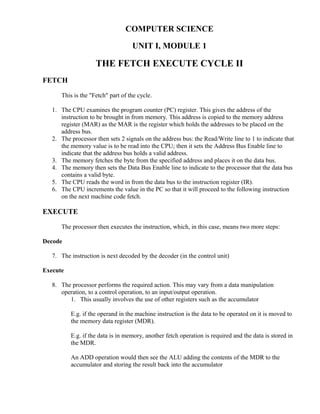Report
Share

Recommended
Recommended
Microprocessor systems (4)

Microprocessor systems (4)Quaid-e-Awam University of Engineering Science and Technology Nawabshah Sindh Pakistan
More Related Content
What's hot
What's hot (20)
IJCER (www.ijceronline.com) International Journal of computational Engineerin...

IJCER (www.ijceronline.com) International Journal of computational Engineerin...
Similar to 09 the fetch-execute cycle ii
Similar to 09 the fetch-execute cycle ii (20)
computer architecture and the fetch execute cycle By ZAK

computer architecture and the fetch execute cycle By ZAK
1.3.2 computer architecture and the fetch execute cycle By ZAK

1.3.2 computer architecture and the fetch execute cycle By ZAK
Recently uploaded
“Oh GOSH! Reflecting on Hackteria's Collaborative Practices in a Global Do-It...

“Oh GOSH! Reflecting on Hackteria's Collaborative Practices in a Global Do-It...Marc Dusseiller Dusjagr
Organic Name Reactions for the students and aspirants of Chemistry12th.pptx

Organic Name Reactions for the students and aspirants of Chemistry12th.pptxVS Mahajan Coaching Centre
Mattingly "AI & Prompt Design: Structured Data, Assistants, & RAG"

Mattingly "AI & Prompt Design: Structured Data, Assistants, & RAG"National Information Standards Organization (NISO)
Mattingly "AI & Prompt Design: The Basics of Prompt Design"

Mattingly "AI & Prompt Design: The Basics of Prompt Design"National Information Standards Organization (NISO)
Recently uploaded (20)
“Oh GOSH! Reflecting on Hackteria's Collaborative Practices in a Global Do-It...

“Oh GOSH! Reflecting on Hackteria's Collaborative Practices in a Global Do-It...
Introduction to ArtificiaI Intelligence in Higher Education

Introduction to ArtificiaI Intelligence in Higher Education
18-04-UA_REPORT_MEDIALITERAСY_INDEX-DM_23-1-final-eng.pdf

18-04-UA_REPORT_MEDIALITERAСY_INDEX-DM_23-1-final-eng.pdf
Beyond the EU: DORA and NIS 2 Directive's Global Impact

Beyond the EU: DORA and NIS 2 Directive's Global Impact
Interactive Powerpoint_How to Master effective communication

Interactive Powerpoint_How to Master effective communication
Organic Name Reactions for the students and aspirants of Chemistry12th.pptx

Organic Name Reactions for the students and aspirants of Chemistry12th.pptx
Mattingly "AI & Prompt Design: Structured Data, Assistants, & RAG"

Mattingly "AI & Prompt Design: Structured Data, Assistants, & RAG"
Industrial Policy - 1948, 1956, 1973, 1977, 1980, 1991

Industrial Policy - 1948, 1956, 1973, 1977, 1980, 1991
Privatization and Disinvestment - Meaning, Objectives, Advantages and Disadva...

Privatization and Disinvestment - Meaning, Objectives, Advantages and Disadva...
Z Score,T Score, Percential Rank and Box Plot Graph

Z Score,T Score, Percential Rank and Box Plot Graph
Mattingly "AI & Prompt Design: The Basics of Prompt Design"

Mattingly "AI & Prompt Design: The Basics of Prompt Design"
09 the fetch-execute cycle ii
- 1. COMPUTER SCIENCE UNIT I, MODULE 1 THE FETCH EXECUTE CYCLE II FETCH This is the "Fetch" part of the cycle. 1. The CPU examines the program counter (PC) register. This gives the address of the instruction to be brought in from memory. This address is copied to the memory address register (MAR) as the MAR is the register which holds the addresses to be placed on the address bus. 2. The processor then sets 2 signals on the address bus: the Read/Write line to 1 to indicate that the memory value is to be read into the CPU; then it sets the Address Bus Enable line to indicate that the address bus holds a valid address. 3. The memory fetches the byte from the specified address and places it on the data bus. 4. The memory then sets the Data Bus Enable line to indicate to the processor that the data bus contains a valid byte. 5. The CPU reads the word in from the data bus to the instruction register (IR). 6. The CPU increments the value in the PC so that it will proceed to the following instruction on the next machine code fetch. EXECUTE The processor then executes the instruction, which, in this case, means two more steps: Decode 7. The instruction is next decoded by the decoder (in the control unit) Execute 8. The processor performs the required action. This may vary from a data manipulation operation, to a control operation, to an input/output operation. 1. This usually involves the use of other registers such as the accumulator E.g. if the operand in the machine instruction is the data to be operated on it is moved to the memory data register (MDR). E.g. if the data is in memory, another fetch operation is required and the data is stored in the MDR. An ADD operation would then see the ALU adding the contents of the MDR to the accumulator and storing the result back into the accumulator
